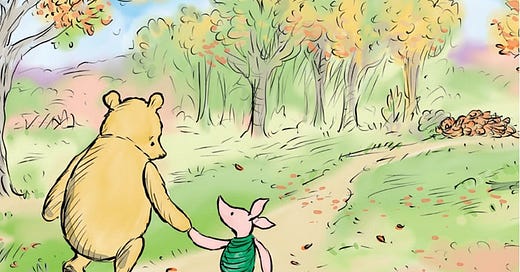Hi 👋 friends,
💡 One Insight
This week, I was reading to my 3-year-old nephew when he stopped me mid-sentence to ask:
“Why is Pooh sad? Did someone hurt his feelings?”
He was tracking facial expressions. He was trying to figure out why someone felt something. He was mentalising — the developmental process where we learn to recognise that others have thoughts, feelings, and beliefs different from our own.
It’s made me reflect on the power of stories as a tool in understanding our mind and the mind of others. Stories we read or watch alone, stories we share with others at a book club or when you’re seeing if we think the same things on my YouTube reaction videos, patient stories we hear as healthcare professionals, and our own narrative and stories we form about ourselves and others – stories where our imperfect memories can mean that sometimes they veer more into a territory of fiction – anyone who has been to therapy will be able to relate to this.
In my opinion, the best stories are all about empathy. When we read, our brains activate as if we’re experiencing what the character experiences — a phenomenon that psychologists term narrative transportation. Sometimes we click with characters that mirror our own experience or depict something aspirational. Sometimes we project our own struggles onto these characters.
For children and adults alike, stories help us decode emotional expressions (either in words or facial expressions in picture books), explore motivations, and practice emotional regulation in a safe container.
Who am I?
Hi 👋 friends, thank you so much for subscribing to my newsletter. I’m Elliott, a doctor and psychiatrist in the UK I make content about how to use an understanding of mental health 🧠. I hope that you will find this helpful in knowing how to use your mind as a tool of strength.
🧠 One Strategy
The “Feel-Think-Do” Method when reading or watching anything:
Feel: What might the character be feeling right now?
Think: What thoughts are driving that feeling?
Do: Why are they acting this way? What would you do instead (remembering that others have minds that are separate and might function differently to our own)?
🔁 One Shift
Instead of bingeing for escape, engage with stories for insight. Next time you have an intense emotional response when you read or watch something, ask:
Who or what do I identify with?
What does this story reveal about how I process conflict, love, anger, or joy?
📌 One Resource
“Sometimes,” said Pooh, “the smallest things take up the most room in your heart.”
Winnie-the-Pooh by AA Milne
Inspired by being in the moment with my nephew this week that inspired today’s newsletter.
📣 One Question for You
What’s a story (from childhood or recently) that helped you understand your own emotions better — or someone else's? What was it about the story that resonated with you?
Let’s Connect
▶️ YouTube: / drelliottcarthy
📸 Instagram: / dr.elliott.carthy
🎥 TikTok: / drelliottcarthy
👨💻 Linkedin: / elliottcarthy
🌍 My website: https://www.drelliottcarthy.com
Before you go…
I’d love to know if any of this resonated with you. Leave a comment if you’re comfortable sharing x
Do check out my reaction video on: Doctor Reacts to Medical and Mental Health Memes





I was asked to write an article about being disabled and a sewer.
As I wrote about how the fashion industry isn't set up for mobility challenged people I became aware of how much trust I've lost in systems and how developing and creating different ways of doing things is a strength and not a form of weakness where this is the best I'm going to get.
It was really empowering to think that I'm making, admittedly small but helpful changes for the small group of people I make clothes for
The Berenstain Bears books from childhood were a massive portal into loads of different kinds relationship dynamics and empathy - for anyone not familiar, they had all kinds of stories about family, friendships, coaches, bullies, etc I remember how enjoyable and immersive the stories were, and how they introduced so much perspective taking.